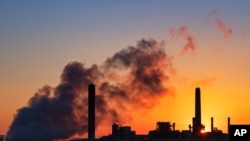When Donald Trump was elected president nearly four years ago, experts expected his policies would end up raising U.S. greenhouse gas emissions significantly.
"President Trump has fulfilled that expectation," said Michael Gerrard, director of the Sabin Center for Climate Change Law at Columbia University.
A recent analysis from research firm the Rhodium Group calculates that the most significant Trump administration rule rollbacks will mean total cumulative U.S. emissions will be 3% higher by 2035 than they would have been without them.
At a time when scientists say greenhouse gas emissions need to be falling sharply in order to stave off the worst impacts of climate change, the analysis shows Trump's policies pointing the United States in the wrong direction.
It's not clear if Trump's looser rules will stick, however.
"Everything that the Trump administration has done to roll back the regulations is being challenged in court," Gerrard said.
If Trump loses the upcoming election, he added, the next administration is unlikely to pursue the court cases.
Vehicle rules
The Trump administration has canceled his predecessor's plan to cut carbon dioxide from electric power plants and replaced it with a much more lenient rule.
Trump has loosened rules for oil and gas companies to control leaks of methane, a potent greenhouse gas.
But the rollbacks with the biggest impact, experts say, have been the ones affecting cars and trucks.
The Obama administration had required automakers to increase the average efficiency of their fleets by about 5% each year. Trump brought that down to about 1.5%.
The new rules are "updating costly, increasingly unachievable fuel economy and vehicle CO2 emissions standards," Transportation Secretary Elaine Chao said in a statement.
The lowered standards account for about a quarter of the Trump administration's emissions increase in the Rhodium report.
But a bigger impact comes from the administration's move to revoke states' ability to set their own standards.
The federal Clean Air Act of 1970 granted California a waiver to set stricter air pollution rules than the national requirements. More than a dozen other states have adopted California's standards. Since these states together account for more than a third of the national car market, automakers generally build all their vehicles to meet California's standards.
But Trump withdrew California's waiver in order to "establish uniform fuel economy standards for vehicles across the United States, ensuring that no state has the authority to opt out of the nation's rules, and no state has the right to impose its policies on the rest of the country," Chao said in a statement.
Rhodium chalks up nearly a third of Trump's increased greenhouse gas tally to this policy alone.
But California pushed back. Going around the Trump administration, the state reached an agreement with five major automakers to raise their efficiency standards by 3.7% per year. That rate falls in between the Obama and Trump requirements. It claws back about a quarter of the emissions increase from the Trump rollback.
Filling the void
That move highlights the role that states, local governments and businesses are playing in trying to make up for backsliding from the federal government.
Virginia this year became the eighth state, and the first in the South, to require all electricity to come from renewable sources by 2050. Houston joined more than 160 cities committing to renewable energy. Ridesharing company Lyft said all vehicles in its service would be electric by 2030.
Altogether, states, cities and businesses could cut U.S. emissions by as much as 37% by 2030 even without the federal government, according to a report co-authored by World Resources Institute climate policy expert Devashree Saha, though it requires much more action than is taking place currently.
That falls short of the 45% to 50% cut needed to get the United States on track to meet the target set out in the 2015 U.N. Paris climate agreement, Saha said.
"Obviously, we can be doing much better, at a faster pace, if we have help from the federal government," she added.
That help is unlikely to come in a second Trump term, she added.











